


As the most concentrated form of wealth on the planet, natural coloured diamonds represent a very unique form of "crystalline art". The beauty and mosaic arrangement of transparent, reflected colours seen in the face-up direction of a polished coloured diamond is literally "indescribable", similar to looking at other natural colour items, such as rainbows, butterflies, flowers, sunsets, etc. In natural coloured diamonds, their indescribable beauty is due to the incredible number of inherent body colours that nature has instilled in diamonds, combined with the infinite assortment of colour patterns seen in the face-up direction of every polished coloured diamond.
Natural coloured diamonds occur in fourteen (14) visually distinct colours (hues), known as colour varieties (e.g., colourless, white, gray, black, violet, purple, pink, red, orange, brown, yellow, olive, green and blue). In addition, each of these fourteen colour varieties exhibit an incredible range of colours based on whether the colour is pure (e.g., blue), or if the main colour has a secondary colour (modifier) mixed with it (e.g., greenish blue, grayish blue, etc.). Nature has created a remarkable assortment of colour modifiers in diamonds, which might involve one modifier, or in some cases, more than one colour modifier (e.g., brownish yellowish orange, bluish gray-violet, brownish reddish orange-pink, etc.).
In addition to the basic fourteen (14) colour varieties and the numerous combinations of secondary colours (300+), each coloured diamond also exhibits visual differences in the lightness (which can range from very light to very dark), and visual differences in the saturation (which can range from weak to very strong depending on the colour). Therefore, the total number of diamond colours available in nature is inconceivable, presenting many more colours and combinations than people realize. In fact, there are so many different and unusual colours present in diamonds, it requires the use of colour measurement instruments just to organize all the colours nature has made, as there are literally thousands and thousands of diamond colours!
Each rough coloured diamond is a remarkable expression of what nature is capable of producing deep within the earth under a certain set of physical and chemical conditions involving extreme heat and pressure, various impurity atoms, and/or natural radiation. Therefore, each diamond crystal has a unique story of how it acquired its particular colour from nature, often with a slight twist of fate, endowing certain stones with unusual and subtle qualities of colour that often go unnoticed or unappreciated by the novice eye.
For example, when I first look at a coloured diamond for a client, I look to see if it is a "true gem", i.e., a crystalline work of art, polished by a knowledgeable diamond cutter, someone who knew exactly how to get the light rays to "dance" inside the diamond, creating a visual masterpiece of geometric colour patches (i.e., mosaic) in the face-up view.
What the diamond cutter does when he cuts and polishes a stone is pure artistry. Each cutter strives to craft the utmost beauty, colour, strength, brilliance and aesthetic quality into the face-up direction of a polished gem, creating an undulating mosaic of transparent coloured reflections, confined within the adamantine walls of a polished coloured diamond. The cutter does all this colour manipulation with minimal weight loss and careful attention to many other details (e.g., polish, symmetry, shape, style of cut, clarity, proportions, dispersion, scintillation, beauty, etc.).
After I have examined the colour of a polished coloured diamond with my eyes, the next step is to measure the colour with an instrument. For this, I employ optical instruments which are specifically designed to measure the colour of polished coloured gemstones. The numerical colour data is then plotted on 2-dimensional charts which enable me to pinpoint the diamond's colour within 3-D colour space, and to specify the exact colour in terms of the three elements that are basic to all colours: hue, lightness, and saturation.
Next, I analyze all the details of the cut (shape, facet design, style, polish, proportions, etc.), and all the precise details of the colour (hue, lightness, saturation, fluorescence, transparency, etc.), in an effort to determine which diamonds were cut and polished to bring out the so-called "best" colour in the face-up view.
Finally, (in each Hofer Letter), I explain the complex "mosaic of colour" seen in the face-up direction of a polished diamond (i.e., various tones for a specific hue), in such a way that the client can understand and appreciate the beauty apparent in each distinctive polished gemstone. Unlocking these mysteries of colour in diamonds is my passion, and then explaining these subtle colour differences to an interested collector or investor is my reward.

















